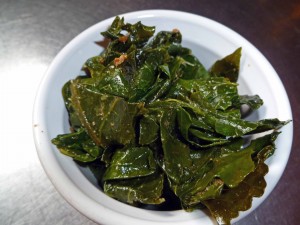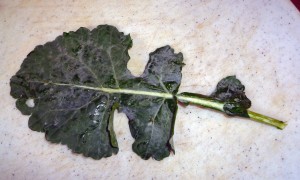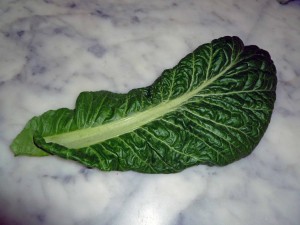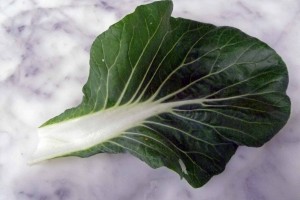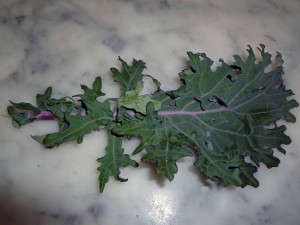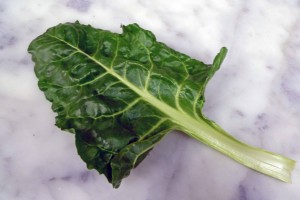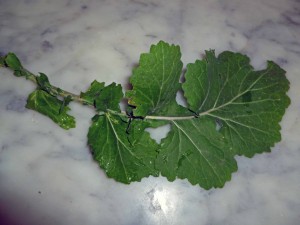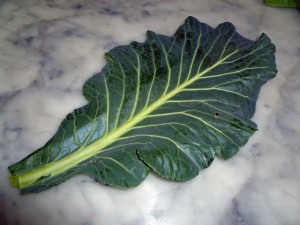Greens are pretty much misunderstood – as in mustard, kale, collards, rape, turnip, swiss chard, choi (like bok choi), so let’s talk greens. Sometimes I take for granted that people know about greens and what to do with them, but the only greens I knew were swiss chard, until I was vegetarian (in what seems like another life!). Even though I’m obviously not vegetarian anymore (when you cook for an omnivore – it just happens!), it was a great way to learn a lot more about vegetables.
You’ll see pictures of the leaves, and then what they look like cooked, and I’ll give you some simple cooking methods. If you raise your own, they’ll be better, and you’ll have greater variety. It’s hard to beat the taste and nutrition of something you pluck out of your garden, even if that garden is a large pot. Greens are some of the simplest vegetables to grow from seed, and pack a huge nutrition punch. They are an excellent source of vitamin A, vitamin K, vitamin C, calcium, and iron (other vitamins and minerals are present but not quite as plentiful). It’s interesting that greens have more vitamin C per serving than citrus fruit. And you can grow some type of green all year. In one of my former jobs, after the board meetings, there were a few people who packed up all the ornamental kale that decorated the platters and gave it to me. They knew I would cook it and bring it back for them to eat the next day! Once you taste greens cooked well, it’s hard not to have them in your diet. Even now it surprises me that my husband asks for them.
One of the greens that’s new to my garden this year is “rape.” My neighbor, who has a huge garden, told me how good it was, so I decided to try it. It has become one of my favorites. Pictured below, the leaf looks a little like a turnip leaf, but has the texture of a collard leaf, and the taste is almost slightly sweet. I put oil in a pan on medium, wilted them down, added sherry, then broth, granulated onion powder, granulated garlic powder, salt and pepper. Depending on the stalk that the green has, will determine whether you need to remove it. Generally, for collards, rape, kale, and usually turnip, I remove the stem. Just fold them in half and rip it out. For swiss chard, choi, and Asian mustards, the stem is tender, so cook it too. Cut or rip greens into whatever size you want.
Below is a picture of an Asian mustard. To cook them, I put a little oil in a pan on medium heat, added the greens, stirred occasionally until wilted down, then added sherry or wine, covered and cooked down. Don’t let them dry out and char on the bottom of the pan, there’s no bringing them back and it’s bitter. It probably happens every once in a while to everyone who cooks greens, or at least it does to me! I just forget about them sometimes. These needed to cook more, so I added a little broth. Then I added oyster sauce, and that’s it. Frankly Delicious is a great seasoning for mustards also. Click here for the information in a previous post about Frankly Delicious.
So if you’ve seen cooked greens, they all pretty much look alike, in that state. Below are pictures of the raw leaves.
(above) This is a Choi. It’s great to cut up and add to stir-fries or saute it with ginger, garlic, a little soy sauce and finish with a little toasted sesame oil. It’s a quick cook.
(above) Red Russian Kale, it’s one of my favorites. There’s a link to a previous recipe at the end of this post. Another way to fix this is to toss the leaves with extra virgin olive oil, salt, and pepper, lay them flat on a cookie sheet. Bake at 350 for about 15 min. until they’re crisp, and you have kale chips.
(above) Swiss Chard, it’s great to cook any way you cook greens. The taste is a little stronger than spinach. Our family recipe was to saute it with garlic, then add tomatoes, fresh basil, salt and pepper. Let it cook until it’s done like you like it.
(above) Turnip Green
(above) Collard Green
Basically, the combination for cooking greens is a fat (including bacon – but use uncured when possible), liquid, and spices. Lots of people use diced ham or bacon in their greens. Sometimes I use fresh garlic and / or fresh onion. You can always add diced potatoes, turnips, rutabaga, or kohlarabi to your greens. For longer cooking greens, add the root vegetables when they (the greens) are partially cooked. And you just cook greens to your desired doneness. There are greens I only cook a few minutes, like bok choi, and there are greens like collards I cook for 45 minutes. Combining different types of greens and cooking them together works really well. Some recipes already on this site are: Cream Collards, Oven Greens, and Cranberry Pecan Kale.
